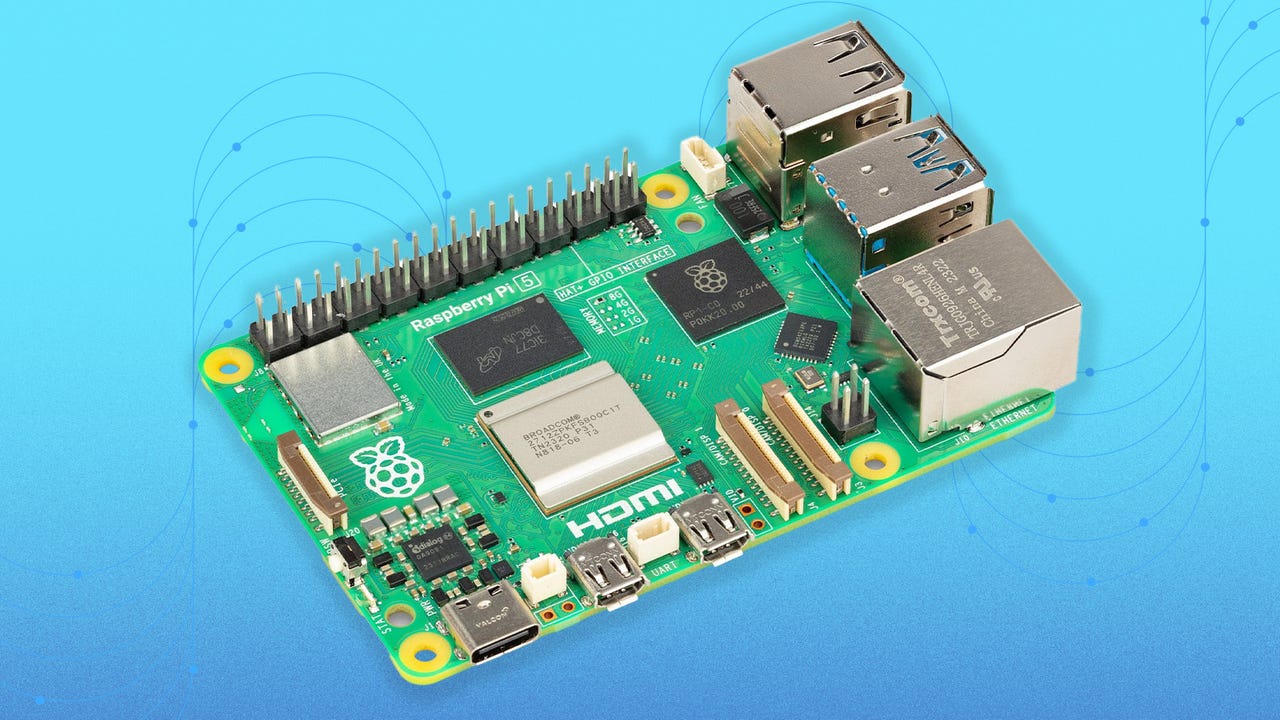
Raspberry Pi 5 Raspberry Pi/ZDNET
Surprise! Details of the Raspberry Pi 5 are out, and while you can’t get your hands on a board just yet, you can bask in the new features and improvements.
Also: How to set up your first Raspberry Pi
At the top of them is a new chip, designed in‑house in Cambridge, UK.
The Broadcom BCM2712 quad-core 64-bit Arm Cortex-A76 processor is three generations ahead of the one used in the Raspberry Pi 4, and is not only faster than the old chip — between two and three times faster — but it also consumes less power, which in turn should mean it runs cooler.
Raspberry Pi 5 tech specs
- 2.4GHz quad-core 64-bit Arm Cortex-A76 CPU
- VideoCore VII GPU, supporting OpenGL ES 3.1, Vulkan 1.2
- Dual 4Kp60 HDMI display output
- 4Kp60 HEVC decoder
- LPDDR4X-4267 SDRAM (4GB and 8GB available)
- Dual-band 802.11ac Wi-Fi
- Bluetooth 5.0 / Bluetooth Low Energy (BLE)
- High-speed microSD card interface with SDR104 mode support
- 2 × USB 3.0 ports, supporting simultaneous 5Gbps operation
- 2 × USB 2.0 ports
- Gigabit Ethernet, with PoE+ support (requires separate PoE+ HAT, coming soon)
- 2 × 4-lane MIPI camera/display transceivers
- PCIe 2.0 x1 interface for fast peripherals
- Raspberry Pi standard 40-pin GPIO header
- Real-time clock
- Power button
The Raspberry Pi 5 has a new processor — the Broadcom BCM2712 quad-core 64-bit Arm Cortex-A76 processor Raspberry Pi/ZDNET
The GPU also gets a boost, with the new Broadcom VideoCore VII, again developed in Cambridge, UK, offering twice the performance of the older GPU. It has support for two 4K60 displays, a big increase from the single 4K30 display that the Raspberry Pi 4 could drive.
Also: How I solved one of my biggest Raspberry Pi headaches
There’s also a new chip — the RP1 — which is the I/O controller for the Raspberry Pi 5. It provides support for two USB 3.0 and two USB 2.0 interfaces, and the Gigabit Ethernet controller. It also handles the two four-lane MIPI transceivers for camera and display, the analog video output, and the 3.3V general-purpose I/O (GPIO).
There’s also twice the USB 3 bandwidth, and there’s even a single lane of PCIe that will allow users to attach high-bandwidth PCIe and NMVe devices to the Raspberry Pi 5.
Even SD card access speeds have been doubled! Oh, and there’s now a power button on the board!
The Raspberry Pi 5 is slightly more expensive than the Raspberry Pi 4 — the version with 4GB of RAM is $60, while the 8GB version for $80 — and because of changes in the layout of ports, you will need to buy a new case.
The layout of the Raspberry Pi 5 is slightly changed, which means owners can’t use old Raspberry Pi 4 cases Raspberry Pi/ZDNET
As with previous Raspberry Pi boards, this one is also built at the Sony UK Technology Centre in Pencoed, South Wales, UK.
The Raspberry Pi 5 is available for pre-order starting today, and boards will begin shipping in October.
Featured reviews




















